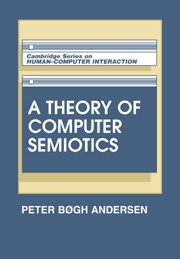
-
Select format
-
- Publisher:
- Cambridge University Press
- Publication date:
- 26 March 2010
- 25 January 1991
- ISBN:
- 9780511665660
- 9780521393362
- 9780521448680
- Dimensions:
- (247 x 174 mm)
- Weight & Pages:
- 0.918kg, 458 Pages
- Dimensions:
- (247 x 174 mm)
- Weight & Pages:
- 0.935kg, 460 Pages
You may already have access via personal or institutional login- Series:
- Cambridge Series on Human-Computer Interaction (3)
Book description
Semiotics is the science of signs: graphical, such as pictures; verbal (writing or sounds); or others such as body gestures and clothes. Computer semiotics studies the special nature of computer-based signs and how they function in use. This 1991 book is based on ten years of empirical research on computer usage in work situations and contains material from a course taught by the author. It introduces basic traditional semiotic concepts and adapts them so that they become useful for analysing and designing computer systems in their symbolic context of work. It presents a novel approach to the subject, rich in examples, in that it is both theoretically systematic and practical. The author refers to and reinterprets techniques already used so that readers can deepen their understanding. In addition, it offers new techniques and a consistent perspective on computer systems that is particularly appropriate for new hardware and software (e.g. hypermedia) whose main functions are presentation and communication. This is a highly important work whose influence will be wide and longlasting.
Reviews
"...it will introduce you to a new way of thinking about programs and how people use them." Vivienne S. Begg, Computer
"Because it systematically develops how semiotics can be applied to the study of human-computer interactions, HCI researchers will find the book stimulating, even if their own approach is different. Finally, systems builders who are languishing for lack of a methodology could do worse than to review Andersen's approach." H. Van Dyke Parunak, Computing Reviews
"The book is a bold enterprise. It is an interesting and sometimes fascinating stab at a statement of a theory that is needed." Robin Fawcett, Computational Linguistics
"Andersen not only provides semiotic means of evaluation, he also presents a further development of the two concepts, which may open interesting perspectives not only for computer scientists but also for semioticians. His typology of speech acts, in particular, introduces a new approach that could prove useful to speech-act theorists." Bernhard Debatin, Semiotic Review of Books
"This book is a refreshing one: it aims to explore computer systems within the paradigm of semiotics instead of within the more restricted purview of logic or linguistics and manages to open new conceptual horizons." Jean Guy Meunier, Semiotica
Contents
Metrics
Altmetric attention score
Full text views
Full text views help Loading metrics...
Loading metrics...
* Views captured on Cambridge Core between #date#. This data will be updated every 24 hours.
Usage data cannot currently be displayed.
Accessibility standard: Unknown
Why this information is here
This section outlines the accessibility features of this content - including support for screen readers, full keyboard navigation and high-contrast display options. This may not be relevant for you.
Accessibility Information
Accessibility compliance for the PDF of this book is currently unknown and may be updated in the future.


